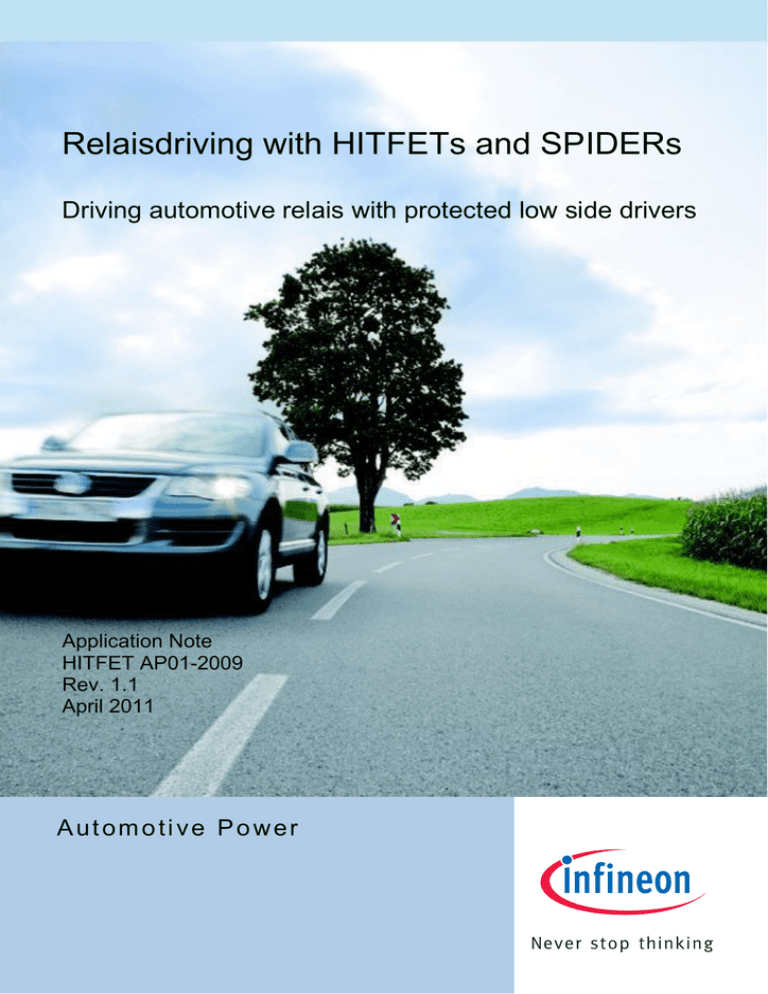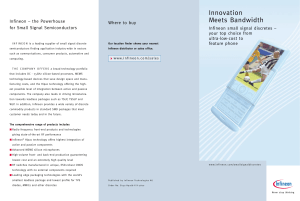
Relaisdriving with HITFETs and SPIDERs
Driving automotive relais with protected low side drivers
Application Note
HITFET AP01-2009
Rev. 1.1
April 2011
Automotive Power
Application Note (AP01-2009)
HITFETS
Table of Contents
Table of Contents
1
Abstract .......................................................................................................................................... 3
2
Introduction ................................................................................................................................... 3
3
3.1
3.2
Relay as load from the driver perspective.................................................................................. 3
Electrical description of the automotive relais ................................................................................. 5
Applied circuitry ............................................................................................................................... 5
4
4.1
Infineon solution ........................................................................................................................... 6
Portfolio Overview ........................................................................................................................... 7
5
Summary ........................................................................................................................................ 8
6
Demo- or Evaluation Boards available ....................................................................................... 8
7
Contact and Ordering Information .............................................................................................. 8
Application Note
2
April 2011
Application Note (AP01-2009)
Relaisdriving with SPIDER and HITFET
1
Abstract
This application note should be a short introduction into the automotive relay driving
application and give an overview of the Infineon HITFETTM and SPIDER devices
which are designed for protected lowside relay driving.
We will continue to improve the content and update the information as necessary.
2
Introduction
Even so the Relay is the oldest switch in the electronical portfolio; it is still widely
used. Semiconductors strive to replace these “dinosaurs” since more than half a
century now. In many areas with remarkable success, however some applications
will still use mechanical relays in the next decades to come.
Fault detection and protection are safety features which are widely required today
in automotive and industrial applications. A classical mechnical relay has not much
to offer in this respect. The protected relay driver needs to protect a shorted coil of
the relay from overcurrent and feedback the situation to the microcontroller.
3
Relay as load from the driver perspective
Driving a relay is one of the oldest tasks in electronic history. Therefore everybody
assumes it is a trivial thing to do. But the surprising part on it is that the load is quite
unknown. The switching coil of the Relay is widely neglected in the Datasheets of
the Manufacturer. Only a few specify a typical coil resistance, nearly none is
mentioning the typical inductance. Not a single one specifies a maximum or
minimum value for the coil resistance. Furthermore the variety of relays is adding
more uncertainty to the design. There are more than 750 different relais used in
automotive applications 1 and a generic driver has to be able to drive them all.
Figure1 shows a few automotive relais used today.
Figure 1
Application Note
Different automotive Relais in same scale
3
April 2011
Application Note (AP01-2009)
Relaisdriving with SPIDER and HITFET
In addition to this wide spread of parameters in the relay family, there are dynamic
changes of the Inductance. These changes are happening in all relays. During
switching, the inductance of a relay changes due to a changing magnetic
resistance. When the anchor is lifted, the magnetic flow sees a higher resistance
and therefore the inductance changes to a lower value during switch off.
This reflects electrical in a current change during switch ON and a voltage change
in switch OFF. Therefore the moment when the load contacts are opening or
closing can be seen on the scope.
Figure 2 sketches the current and voltage during switch ON and OFF of a relay.
Figure 2
Current and voltage change during relay switching
(Ch3: Drain current, Ch2: Drain voltage and Ch1: IN voltage)
In the right picture of Figure 2 a voltage rise during switch off above battery level
can be seen. This is due to the physical effect that the magnetic energy in the coil
raises the voltage on a lowside switch and lowers it on a highside one. The
phenomenon is also known as “opening spark”. Some relais have built in parallel
resistors to limit this voltage, but most leave it up to the circuit designer to take care
on it. Some older Relais had freewheeling diodes included, but this became very
unpopular as it reduces the Relaylifetime and causes overload in reverse polarity.
Infineon HITFETTM and SPIDER have an internal clamping to limit this voltage.
Application Note
4
April 2011
Application Note (AP01-2009)
Relaisdriving with SPIDER and HITFET
3.1
Electrical description of the automotive relais
In order to get repetive and compareable lab results, there is a schematic defined to
replace the unpredictable relay coil.
This circuitry consists out of an inductance and a serial resistor with an optional
parallel resistor. The serial resistor represents the copper wire resistance of the coil.
Typical resistor values at room temperature are 60 Ohm to 90 Ohm, while the
inductance ranges from 400mH to 600mH for a automotive 12V Relay. If a parallel
resistor is built in, the value ranges usually from 460 Ohm to 680 Ohm.
Figure 3
3.2
Electrical schematic
vs.
Picture of Relay with built in parallel resistor
Applied circuitry
In the real application there are several different ways of implementing the driver.
SPIDER and HITFET TM can handle all of them.
Figure 4
Application Note
Relays in different application circuits driven by a HS/LS SPIDER Device
5
April 2011
Application Note (AP01-2009)
Relaisdriving with SPIDER and HITFET
The Figure 4 shows 6 Relays and 2 signal LEDs in different application setups.
There are relais in high- and lowside configuration, with and without parallel
resistors, serial diodes and even with the very rare free wheeling diodes.
Serial diodes are not necessary except in case of a freewheeling diode. However
sometimes it is not allowed to switch the relay during a reverse polarity event, then
the diodes are needed.
4
Infineon solution
Infineon offers the SPIDER and HITFET TM devices with all the functions already
integrated into the device. All Devices in the family offer
•
•
•
•
ESD protection
Over load protection
Short circuit protection and detection
Internal clamping to overcome the “opening spark” phenomena
All SPIDER offer additionally open load detection and SPI Interfaces, while all
HITFET’s offer additionally cranking capability down to 2V.
There are 2 types of protection modes available, latch and restart.
Latching devices are staying off after a protective switch off until the microcontroller
resets the device. Despite this a restarting device is switching on again after the
device is cooled down below a certain threshold temperature.
Also there are 2 different types of over current protection:
current limitation and threshold.
Limiting devices are limiting the relais current to a specified value and heating up.
The over current switch off is then triggered by the temperature sensor.
Threshold devices are switching off as soon as a certain threshold current is
reached.
Both protection types are suitable for Relaydriving.
The type of protection needs to be considered when it comes to inrush or capacitive
loads.
As threshold protection concepts are triggered from empty capacitors in the load
path, while current limiting devices can handle this situation very well.
A threshold protected Device can drive a capacitor anyway, but needs a few
restarts from microcontroller.
Application Note
6
April 2011
Application Note (AP01-2009)
Relaisdriving with SPIDER and HITFET
4.1
Portfolio Overview
Infineon’s SPIDERs and HITFETs for Relaydriving are summarized in this table.
Device
Package
Protection
type
Qualification RoHS
Type
Target market (Green) Description
ATV = automotive
I = industrial
SPIDER
TLE7231G
TLE7233G
DSO14 &
SSOP24
ESD, Temp, V, I,
diagnostic
AEC Q100
ATV, I , all
Yes
TLE7234G
TLE7235G
TLE7236G
TLE7237SL
TLE7238SL
TLE7239SL
DSO20 &
SSOP24
ESD, Temp, V, I,
diagnostic
AEC Q100
ATV, I , all
Yes
TLE7240SL
TLE7243SL
TLE7244SL
SSOP24
ESD, Temp, V, I,
diagnostic
AEC Q100
ATV, I , all
Yes
ESD, Temp, V, I
ESD, Temp, V, I,
diagnostic
ESD, Temp, V, I,
diagnostic
ESD, Temp, V, I,
diagnostic
ESD, Temp, V, I,
diagnostic
ESD, Temp, V, I,
diagnostic
ESD, Temp, V, I,
diagnostic
AEC Q100
ATV, Industrial , all
AEC Q100
ATV 12V & 24V, all
AEC Q100
ATV, Industrial , all
AEC Q100
ATV, Industrial , all
AEC Q100
ATV, Industrial , all
AEC Q100
ATV, Industrial , all
AEC Q100
ATV, Industrial , all
4ch low side SPI
driver for Relay and
LED, latch.
Threshold
8ch low and high side
SPI driver for Relay
and LED, latch.
threshold
8ch low side SPI
driver for Relay and
LED, latch.
threshold
HITFET
BTS3800SL
SCT595
BSP75N
SOT223
BSP76
SOT223
BTS3110N
BTS3205
SOT223
DS08 &
SOT223
BTS3207N
SOT223
BTS3405G
DS08
Yes
Yes
Yes
Yes
Yes
Yes
Yes
Yes
BTS117TC
D2PAK
BTS3408G
DS08
BTS3410G
DS08
ESD, Temp, V, I
ESD, Temp, V, I,
diagnostic, open
load detection
ESD, Temp, V, I,
diagnostic
AEC Q100
ATV 12V & 24V, all
Yes
AEC Q100
ATV 12V & 24V, all
AEC Q100
ATV, Industrial , all
Latching,
threshold
Restart, 60V+,
Limiting
Restart ,
Limiting
Latch;
Limiting
Restart,
limiting
Restart,
limiting
Restart, 2ch ,
Limiting
Latch,
60V+,
Limiting
Restart, 2ch,
60V+,
Limiting
Yes
Restart, 2ch
Table1 Infineon portfolio of protected relay low side switches
Application Note
7
April 2011
Application Note (AP01-2009)
Relaisdriving with SPIDER and HITFET
For more information, datasheets, order, contact information please check our
homepage out: www.infineon.com/hitfet or www.infineon.com/spider
5
Summary
Relaydriving will be still needed in automotive design for the next decade
to come. Infineon provides with the HITFETTM and SPIDER products a
simple and fast design in solution with high reliability and robustness.
These are qualities that are proven in hundreds of millions of HITFETs
and SPIDERs, which are used today in a wide range of automotive and
industrial electronics. The families just recently released new parts to
serve this market best.
The HITFET BTS3205G&N and BTS3405G offer a scalable single / dual
channel solution. While the TLE724xSL family features a fully scalable
8ch solution with 4 direct driven channels and limp home capability.
6
Demo- or Evaluation Boards available
Infineon provides for all SPIDER products and for many HITFET products
evaluation boards. These boards enable a fast start up and in case of
SPIDER come along with software to allow a fast usage and
customization of the SPI functionality.
7
Contact and Ordering Information
For more information, datasheets, order, contact information please check our
homepage out: www.infineon.com/hitfet or www.infineon.com/spider
You can also send us an email at:
http://www.infineon.com/cms/en/product/channel.html?channel=ff80808112ab681d
0112ab69ddae0347&tab=contacts
Or call us:
International Toll Free: 0(0) 800 951 951 951
Direct Access:
Application Note
+49 89 234 65555
8
April 2011
Application Note (AP01-2009)
Relaisdriving with SPIDER and HITFET
AP Number: AP01-2009
Revision History:
Version Date
1.1
April 2011
1.0
August 2009
Application Note
Changes
Added BTS3800SL , updated and reformatted Table,
updated Footnote and history
Initial version
9
April 2011
1
Source: Relaytypes listed in ordering system of a representative European automotive OEM
Edition April 2011
Published by
Infineon Technologies AG
81726 Munich, Germany
© 2011 Infineon Technologies AG
All Rights Reserved.
LEGAL DISCLAIMER
THE INFORMATION GIVEN IN THIS APPLICATION NOTE IS GIVEN AS A HINT FOR THE
IMPLEMENTATION OF THE INFINEON TECHNOLOGIES COMPONENT ONLY AND SHALL NOT BE
REGARDED AS ANY DESCRIPTION OR WARRANTY OF A CERTAIN FUNCTIONALITY, CONDITION OR
QUALITY OF THE INFINEON TECHNOLOGIES COMPONENT. THE RECIPIENT OF THIS APPLICATION
NOTE MUST VERIFY ANY FUNCTION DESCRIBED HEREIN IN THE REAL APPLICATION. INFINEON
TECHNOLOGIES HEREBY DISCLAIMS ANY AND ALL WARRANTIES AND LIABILITIES OF ANY KIND
(INCLUDING WITHOUT LIMITATION WARRANTIES OF NON-INFRINGEMENT OF INTELLECTUAL
PROPERTY RIGHTS OF ANY THIRD PARTY) WITH RESPECT TO ANY AND ALL INFORMATION GIVEN
IN THIS APPLICATION NOTE.
Information
For further information on technology, delivery terms and conditions and prices, please contact the nearest
Infineon Technologies Office (www.infineon.com).
Warnings
Due to technical requirements, components may contain dangerous substances. For information on the
types in question, please contact the nearest Infineon Technologies Office.
Infineon Technologies components may be used in life-support devices or systems only with the express
written approval of Infineon Technologies, if a failure of such components can reasonably be expected to
cause the failure of that life-support device or system or to affect the safety or effectiveness of that device or
system. Life support devices or systems are intended to be implanted in the human body or to support and/or
maintain and sustain and/or protect human life. If they fail, it is reasonable to assume that the health of the
user or other persons may be endangered.



